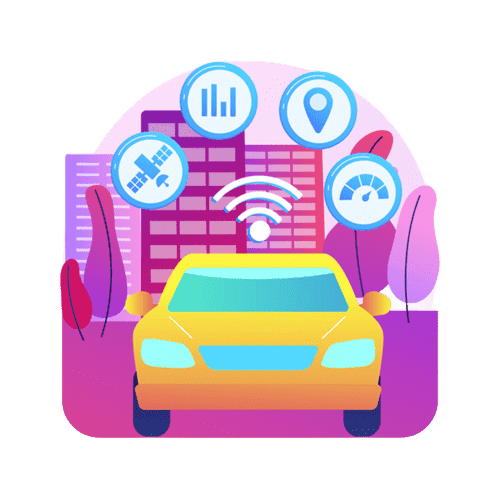[dsm_gradient_text gradient_text="Maintaining ISO 27001 Compliance: Tips for Long-Term Success" _builder_version="4.27.0" _module_preset="default" header_font="Questrial|||on|||||" header_text_align="center" header_letter_spacing="5px" filter_hue_rotate="100deg"...
When Cars Became Code: How AI is Redefining Automotive Production
Electric vehicles (EVs) are no longer science-fiction toys; they’re carving highways into the mainstream. Behind their silent zoom lies an unsung hero: the battery. And today, batteries are getting a brain transplant thanks to artificial intelligence.
A recent paper, Next-generation battery energy management systems in electric vehicles: An overview of artificial intelligence, explores how AI is reinventing Battery Energy Management Systems (BEMS) — the mission control software that keeps EV batteries healthy, safe, and efficient. Let’s cruise through the key points.

The Rise of the Software-Defined Car
From Steel to Software: A Shift Nobody Saw Coming
Once upon a time, cars were about horsepower, chrome bumpers, and maybe a cassette deck if you were fancy. Fast-forward to today, and your car has more lines of code than a Boeing 787 Dreamliner. Yes, you read that right. That hunk of metal in your driveway is less carriage with an engine and more rolling supercomputer.
Modern vehicles are so software-driven that some manufacturers call them smartphones on wheels. Only difference? Your smartphone doesn’t weigh two tons or need brake fluid.
Why does this matter? Because when your car is more about code than carburetors, the game changes. Updates, patches, and bug fixes aren’t optional extras, they’re central to making sure your ride doesn’t glitch out like a half-baked video game release.
The Hidden Orchestra Inside Your Car
Peek under the hood (digitally speaking), and you’ll find a dizzying array of 100+ ECUs (Electronic Control Units). Each ECU is like a tiny computer controlling everything from your headlights to your seat warmers. Add in infotainment systems, sensors for autonomous driving, and cloud-connected services, and suddenly your car is juggling more software systems than an office IT department.
Every one of those systems needs updates. Why?
- Fixing bugs (so your windows don’t roll down in a thunderstorm).
- Adding features (hello, remote start from your phone).
- Keeping up with regulations (because governments don’t joke about safety).
This isn’t an occasional thing. Updates happen constantly during the vehicle production process itself, sometimes even on the assembly line before your shiny new car is shipped out
The Ticking Clock of Updates
Here’s the kicker: carmakers are under insane pressure.
- Update cycles are getting shorter.
- Consumers expect near-instant software fixes (thanks, smartphones).
- Factories can’t afford delays, because in the car world, a halt in production means millions of dollars down the drain.
Imagine you’re building 1,500 cars a day, and suddenly a software update halts the line because the new ECU firmware doesn’t talk properly with the diagnostic tester. That’s not just a glitch, that’s a full-on disaster. This is why updates are both a blessing and a curse: they improve vehicles but can also throw a wrench in the smooth hum of production.
Enter the Ripple Effect
Think of it like this:
- A developer tweaks the code for the driver’s door ECU.
- That tiny change causes an unexpected ripple.
- Suddenly, the car won’t pass final commissioning tests.
- Production halts. Workers twiddle their thumbs. The factory floor loses millions.
This domino effect, called the ripple effect in software engineering, is the stuff of nightmares And here’s the scary part: spotting these ripples in advance is incredibly hard. Most of the time, companies only notice once the damage has already happened.
Why This Matters for the Future
The article we’re basing this series on introduces a bold idea: what if AI, specifically Large Language Models (LLMs), could predict these impacts before they crash the factory line? Picture a system that reads thousands of error reports, testing logs, and update descriptions, then warns: Hey, changing the door ECU parameter data might break the commissioning process in Factory Z. Recheck compatibility before you flash it. That’s not just helpful — it’s revolutionary.
Cars have transformed from mechanical beasts to digital ecosystems. Updates are their lifeblood, but also their Achilles’ heel. Automakers are stuck balancing speed, safety, and stability in a world where every second counts. In the next part, we’ll zoom in on the Update Dilemma: why these updates are both the savior and the saboteur of modern automotive production, and how even the tiniest software tweak can ripple into chaos.
%
new car value from software by 2030
Analysts estimate that 50–70% of a new car’s value by 2030 will come from its software and electronics, not mechanical parts. Source: pwc
%
Automotive recalls caused by software
In recent years, 15% of vehicle recalls have been due to software-related issues, and the proportion is growing. Source: NHTSA
The Update Dilemma – Blessing or Production Nightmare?
Why We Can’t Escape Software Updates
Let’s face it: software updates are the espresso shots of modern car production, they keep everything running but can also leave you jittery if they arrive at the wrong time. On the one hand, updates are essential:
- They fix bugs (because no one wants their rear-view camera freezing mid-parking).
- They add new features (your 2025 car might suddenly have a better lane-assist algorithm than it did yesterday).
- They improve safety (patches that fix vulnerabilities hackers might exploit).
On the other hand, these same updates can derail a production line faster than you can say firmware mismatch.
The Blessing: Cars That Keep Getting Smarter
Remember when buying a car meant what you drove off the lot with was it? No more, no less. If your tape deck broke, tough luck. If you wanted better gas mileage, you bought a new car. Now? A vehicle update can:
- Increase horsepower (yes, some manufacturers unlock performance boosts via software).
- Fix long-standing quirks you didn’t even know were bugs.
- Future-proof your ride so it doesn’t feel outdated two years later.
It’s like your car goes to bed a sedan and wakes up a slightly improved version of itself.
The Curse: Time is Money, and Updates Take Both
Here’s the dark side: updates don’t just happen in your driveway over Wi-Fi. They’re deeply woven into the production process itself.
Picture a factory line:
- Step 1: Assemble the interior.
- Step 2: Flash the ECU with the latest software.
- Step 3: Test and commission the electronics.
- Step 4: Fill up fluids.
- Step 5: Finish the interior.
- Step 6: Flash remaining ECUs.
- Step 7: Test again.
- Step 8: Final quality check.
At multiple points along that chain, software has to be installed, tested, and verified. If a flash takes too long, aborts midway, or introduces a bug, the entire car can get shunted into the dreaded Rework Zone. That’s basically factory purgatory, expensive, time-consuming, and morale-crushing.
The Butterfly (or Ripple) Effect in Action
Let’s dramatize.
A developer somewhere in Stuttgart tweaks a few lines of code for a door ECU. Nothing major, just a parameter data update.
But then:
- On the line, the new code takes 10 extra minutes to flash.
- Multiply that by 1,200 cars in a day.
- Suddenly, the whole production line is backed up by hours.
Or worse, the code breaks compatibility with the diagnostic tester. Cars get stuck in commissioning. Workers can’t move them forward. Production halts. The factory loses millions. The developer loses sleep. And customers? They might end up waiting weeks longer for their shiny new vehicles.
That, my friends, is the ripple effect, a tiny pebble (a small software tweak) causing tsunami-sized waves across the factory floor.
The Balancing Act: Fast vs. Stable
So, what’s the real dilemma? It boils down to this:
- Consumers demand speed. They want the latest updates, yesterday.
- Factories demand stability. They need predictable, uninterrupted production.
Balancing these two is like juggling flaming torches while riding a unicycle. You can do it, but it’s risky. And the stakes are enormous. Unlike apps on your phone, a buggy update in cars isn’t just an inconvenience, it’s a safety issue. Imagine your ABS braking system glitching because of a rushed patch.
Why Traditional Solutions Fall Short
Automakers have long relied on rigorous testing, strict quality assurance, and standardized processes like ASPICE (we’ll cover that in the next part). But here’s the kicker:
- Testing every possible variant of a software update is impossible.
- Suppliers are involved, meaning not all source code is even accessible.
- Updates happen so frequently that old-school verification methods simply can’t keep up.
That’s why production halts, costly rework, and ripple effects are still happening despite decades of process improvements.
Software updates are both the lifeblood and the landmines of modern automotive production. They make cars smarter, safer, and more future-proof, but they also threaten to grind billion-dollar factories to a halt with the tiniest misstep. It’s a high-stakes balancing act where speed and stability constantly clash. But don’t worry, we’ll peek behind the curtain at the standards and safety nets automakers use to manage this madness, including the mysterious ASPICE framewor.
Standards, Safety, and the ASPICE Cookbook
Why Standards Keep Cars (and Factories) From Exploding
Imagine if every chef in a restaurant made spaghetti their own way:
- One adds cinnamon,
- Another decides pasta should be fried,
- A third forgets to cook it at all.
Chaos, right? That’s what car production would look like if automakers didn’t follow standards. With dozens of suppliers, hundreds of software modules, and thousands of workers all contributing, standards are the recipe books that keep the whole kitchen running.
Without them, a single software update could turn a factory into the automotive version of a food fight.
UN Regulation No. 156: The Rulebook of Updates
One of the big rulebooks is UN Regulation No. 156, which defines what a software update actually is:
A package used to upgrade software to a new version including a change of configuration parameters.
That sounds boring, but here’s why it matters: it sets a global baseline for how updates are handled, documented, and tested. Think of it as the DMV handbook of car software: not thrilling, but essential if you don’t want crashes (in either sense of the word).
Enter ASPICE: The Cookbook for Car Coders
Now let’s talk about the star of today’s episode: ASPICE (Automotive Software Process Improvement and Capability Determination).
ASPICE is like the Michelin guide for software development in the automotive industry. It doesn’t tell you exactly how to cook the meal, but it sets out the criteria you need to meet if you want that coveted five-star rating (or in this case, a safe, stable, reliable car).
Here’s the gist:
- ASPICE is based on the international ISO/IEC 15504 standard.
- It’s been tailored specifically for the chaos that is car software.
- Its mission: increase the maturity and efficiency of development processes so cars don’t roll off the line with half-baked code.
Breaking Down the ASPICE Kitchen
Think of the software development process as a giant recipe. ASPICE breaks it down into steps, and at each step, it says:
- What ingredients (information) you need.
- What checks (tests) you must perform.
- What the finished dish (software) should look like.
In the article, ASPICE is shown with an enhanced Software Development Process model
- SDP.1: Requirements Analysis → What does the software need to do?
- SDP.2: Architectural Design → How do we structure it?
- SDP.3: Unit Construction → Write the actual code blocks.
- SDP.4: Coding → Mix, stir, bake.
- SDP.5: Unit Test → Taste-test the small pieces.
- SDP.6: Integration Test → Combine everything and see if it works together.
- SDP.7: System Test → The final tasting menu before serving it to customers.
Now here’s where the fun begins: an LLM-based impact analysis can slot into this recipe book at multiple points. It’s like having an AI sous-chef who whispers:
Careful, last time you added too much chili at this stage, the whole dish got ruined. Maybe adjust the recipe before moving on.
Why This Matters Beyond Bureaucracy
It’s easy to think of standards like ASPICE as red tape. But here’s why they’re lifesavers:
- They force consistency across different suppliers and teams.
- They catch problems early, instead of letting them sneak into production.
- They document everything, so when something goes wrong, you can actually trace back and figure out why.
Without standards, one team’s minor tweak could cascade into a nightmare for everyone else, a ripple effect with no easy way to track it.
The Roadblock: Standards Aren’t Enough
But here’s the catch:
- ASPICE is thorough, but it’s also slow.
- By the time you’ve gone through all the tests and documentation, the software may already be outdated.
- And with updates happening faster than ever, ASPICE alone can’t keep up.
That’s where AI, and specifically LLM-powered impact analysis, enters the chat. Think of it as turbocharging ASPICE with a brain that remembers every past failure and can warn you before you repeat it.
AI to the Rescue – Enter the LLMs
Wait, What’s an LLM Again?
Before we get into car factories, let’s clear this up: an LLM (Large Language Model) isn’t some obscure car part hiding under your hood. It’s artificial intelligence trained on oceans of text, think of it as the ultimate autocomplete, but with the ability to reason, connect dots, and spit out insights that humans might miss. If you’ve ever asked ChatGPT to write a haiku about your dog or debug a chunk of Python code, you’ve already seen an LLM at work. Now, picture that same brainy assistant working inside a car factory.
LLMs as Factory Sidekicks
Imagine a factory engineer who’s seen every single mistake ever made on the assembly line, remembers them all perfectly, and can instantly tell you:
Hey, flashing that new ECU update on Series Model X usually causes problems at Test Station Y. Maybe double-check before you proceed.
That’s exactly what researchers in the article propose: using an LLM-based impact analysis to predict how a software update might ripple through the production line.
The Secret Sauce: Retrieval-Augmented Generation (RAG)
Here’s where things get spicy. A raw LLM is smart but… kinda forgetful. It doesn’t know the latest factory incidents or production quirks unless you feed it context. That’s where RAG (Retrieval-Augmented Generation) comes in. Think of RAG as pairing the genius (the LLM) with a super-librarian who fetches the right documents, error logs, and workflow reports at the right time. Here’s the workflow in plain English:
- Data Collection → Gather natural language reports: errors, incidents, workflow notes.
- Preprocessing → Clean the data (throw out junk like irrelevant details — nobody cares what color the car was when the bug happened).
- Embedding → Turn text into vectors (mathy fingerprints that capture meaning).
- Vector Database → Store all those fingerprints for fast retrieval.
- Query Time → Developer asks a question: “What’s the risk of updating the door ECU on Model Z in Factory Y?”
- Retrieval → RAG fetches the most relevant past incidents.
- Generation → The LLM uses that context to produce a smart, informed answer.
It’s like asking a friend for advice, but that friend has read every manual, test log, and bug report in existence and can recall them instantly.
Example in Action
Suppose a developer enters a query like:
What’s the impact of changing the parameter data of a door control unit software package for Series X, at commissioning Test Location Y, Factory Z?
The LLM might respond:
If you’re just adding new parameters, you’re fine, no impact expected.
But if you’ve changed the structure of existing parameters, the diagnostic tester will break, and you’ll cause major rework on the line.
Boom. Crisis averted.
Instead of finding out the hard way, with broken door units piling up in rework, the developer gets an early warning.
Think of It Like a Cheat Code for Factories
Car factories are like giant multiplayer games. Every player (developer, supplier, line worker) is making moves, and one wrong move can ruin the game for everyone.
LLM + RAG = the cheat code that shows hidden traps before you step on them.
But Don’t Fire the Humans Just Yet
Now, let’s pump the brakes. LLMs aren’t magic:
- They can hallucinate (make up answers with scary confidence).
- They need clean data — garbage in, garbage out.
- Their advice still has to be reviewed by humans (engineers remain the final decision-makers).
Think of them as copilots, not autopilots. They assist, but they don’t get to fly the plane (or in this case, run the factory) alone.
LLMs, supercharged with RAG, are like crystal balls for automotive production. They sift through mountains of messy human-written reports, connect the dots, and flag risks that would otherwise sneak past unnoticed. They don’t replace engineers; they empower them, saving time, money, and sanity on the factory floor.
Case Study Drama – The Door Control Unit Saga
Scene 1: A Calm Factory Morning
It’s 7:00 AM in Stuttgart. The factory hums with the usual rhythm, robots welding, conveyor belts rolling, workers in neon vests sipping their first coffee. Cars glide down the assembly line like clockwork. Then comes a routine step: flashing the software into a door control unit. For most of us, doors are just doors. They open, they close. But inside every modern door is a tiny computer, an ECU (Electronic Control Unit), that manages windows, locks, sensors, even how your car knows the door is closed properly.
Seems simple, right? Wrong.
Scene 2: The Update Arrives
A developer has just pushed a new software package for the door ECU. It’s bundled neatly with three things:
1. A bootloader (to kick-start the ECU).
2. The application software (the brain of the door’s functions).
3. Parameter data (the fine-tuned settings, like this is the left front door or windows stop rolling up if they hit resistance).
Normally, parameter data is just a few bytes, tiny adjustments that let the same software work across different car models and doors. But today’s update isn’t tiny. It includes a structural change in the parameter data. That means the old diagnostic tester, the device workers plug into the car to flash and configure ECUs, no longer speaks the same language.
Scene 3: The Ripple Effect Hits
Here’s what happens next:
- The diagnostic tester tries to flash the ECU.
- Instead of a smooth upload, it chokes on the new parameter structure.
- Suddenly, the door ECU isn’t configured properly.
- Testing and commissioning grind to a halt.
And here’s the kicker: this doesn’t happen to just one car. It happens to every car rolling through that stage of the line. Broken door ECUs start stacking up in the Rework Zone. Engineers scramble to troubleshoot. Production slows. Management frowns at the growing costs.
One small tweak → one giant headache.
Scene 4: How AI Could Have Saved the Day
Now, let’s rewind and play this scenario again, but this time with an LLM-based impact analysis in the loop.
A developer types into the system:
What’s the impact of changing the parameter data of the door control unit for Series X, at commissioning Test Location Y, Factory Z?
The LLM, supercharged with past incident data, replies:
- If you’re only adding parameters, no problem.
- But if you’ve changed the structure, the diagnostic tester will fail unless updated. This could lead to broken door control units and heavy rework effort.
Armed with this warning, the developer double-checks the diagnostic tester. They patch it before the software ever hits the production line. Result No chaos, no rework, no expensive downtime.
Scene 5: Lessons From the Drama
The door ECU saga may sound small, but it highlights the core truth of automotive production:
- Cars are insanely complex digital ecosystems.
- A change in one tiny part can ripple across the whole system.
- Traditional testing can’t possibly cover every variant or configuration.
- But AI, with its ability to learn from past errors and spot patterns, can shine a spotlight on risks before they turn into disasters.
In other words: AI doesn’t just save money — it saves sanity.
What we just saw is more than a factory mishap. It’s a metaphor for the modern automotive industry: small software changes can have big consequences. Without predictive tools, developers are basically driving blind. With AI, they get headlights that show hazards before they crash into them.
Beyond Cars – Where Else Could This Work?
The Big Reveal
Up to now, we’ve been talking cars, cars, cars. But here’s the truth: the idea of using LLM-based impact analysis isn’t confined to automotive factories. Anywhere you’ve got complex products, frequent software updates, and zero tolerance for downtime, this concept could be a game-changer. So let’s take a road trip outside the car industry. Buckle up.
Case 1: Airplanes – Flying Computers
Modern airplanes are basically giant flying servers. A Boeing 787 Dreamliner has around 6.5 million lines of code. Compare that to a Ford F-150 with around 150 million lines of code, and suddenly you realize cars are even crazier than planes, but planes still take the crown for life-or-death stakes. Imagine this:
- A new update is rolled out for the in-flight control system.
- It’s meant to optimize fuel efficiency.
- But it accidentally creates a compatibility issue with the autopilot’s diagnostic system.
Result? Potential flight delays, grounded aircraft, or, in the absolute worst case, safety risks.
Now imagine an LLM-based system analyzing past update incidents across avionics, flagging that a similar ripple effect occurred five years ago on another aircraft model. Boom: problem caught before passengers even board.
Case 2: Smart Factories – The Machines That Build Machines
Factories themselves are increasingly software-driven ecosystems. Robotic arms, conveyor systems, AI vision inspection, all stitched together with code. Picture a packaging robot that gets a software patch:
- It’s supposed to speed up efficiency by 3%.
- Instead, the new logic causes misalignment with the conveyor timing.
- Suddenly, bottles are tipping, breaking, and production halts.
An LLM-based impact analysis trained on previous factory hiccups could say:
Hey, the last time a conveyor timing algorithm was changed, bottle alignment failed. Double-check synchronization before deploying.
This doesn’t just save money. It saves workers from frustration (and from dodging broken glass).
Case 3: Medical Devices – Updates That Save Lives
Pacemakers, insulin pumps, surgical robots, they all run on software. Updates are necessary for safety, but mistakes? Catastrophic.
Imagine a hospital updating its surgical robot:
- The patch improves motion control.
- But it introduces a bug in the calibration process.
- During surgery prep, the robot misaligns by a few millimeters.
That’s not just a production halt, that’s human lives at risk.
With AI-assisted impact analysis, the system might flag:
Calibration routines have historically been sensitive to changes in motion algorithms. Testing required before release.
Suddenly, the difference between a smooth operation and a tragedy is a warning delivered at just the right time.
Case 4: Everyday Gadgets – Your Smart Home
Let’s come back down to earth, literally, to your living room.
Your smart washing machine downloads an update:
- New feature: optimized water usage.
- Unintended effect: the software miscommunicates with the spin cycle controller.
- Outcome: clothes that come out wetter than your average swimming pool towel.
Annoying? Yes. World-ending? No. But it’s a perfect example of how ripple effects show up in daily life.
If companies applied LLM-based analysis here, your washing machine might have warned engineers ahead of time:
Watch out: water-use updates often impact spin cycles. Re-test before release.
Maybe then your laundry wouldn’t feel like it went through a tsunami.
The Pattern Across Industries
What do planes, factories, hospitals, and washing machines all have in common?
- Complex systems.
- Critical dependencies.
- Software updates that can break stuff.
And that’s why the core concept scales: LLMs don’t care if they’re analyzing door ECUs, autopilot software, or spin cycle timing. As long as they have access to good documentation and past error reports, they can find patterns and predict problems.
The Road Ahead – Challenges, Risks, and Sci-Fi Futures
Why the Road Ahead Isn’t All Smooth Asphalt
By now, we’ve seen how LLM-based impact analysis could transform car production (and beyond). But before we all start celebrating our AI copilots, let’s pump the brakes. Because, like any tool, AI brings its own set of risks. And ignoring them would be like ignoring the Check Engine light.
Challenge 1: Hallucinations (The Confident Liar Problem)
LLMs are smart, but sometimes they make stuff up. With a straight face.
Imagine asking your AI: What’s the risk of updating the braking ECU software for Model Y?
And the LLM replies confidently: No issues expected. Go ahead.
But… it’s wrong. And instead of a smooth update, you’ve got a production halt, or worse, a safety issue on the road. This is the hallucination problem: AI generating plausible but false answers. In a factory context, that’s not just embarrassing, it’s expensive (and potentially dangerous).
Challenge 2: Garbage In, Garbage Out
AI is only as good as the data it’s fed. If the incident reports and workflow logs are messy, incomplete, or inconsistent, the predictions won’t be worth much. Think of it like training a chef using random scribbled recipes:
- One recipe says bake at 350°F.
- Another says boil at 350°F.
- Another just says good luck.
The chef (or the AI) is going to struggle.
For LLM-based impact analysis to work, companies need clean, structured, high-quality data pipelines. And let’s be honest, that’s a whole project on its own.
Challenge 3: Over-Reliance on the Robot
There’s a danger in treating AI like an oracle. Humans might be tempted to stop questioning and just trust whatever the model says. That’s risky because:
- AI can miss edge cases.
- AI doesn’t fully understand real-world physics.
- AI doesn’t carry the responsibility when things go wrong — humans do.
So yes, AI is powerful. But it should be a copilot, not the pilot.
Challenge 4: Security and IP Risks
Think about it: if suppliers and automakers are feeding sensitive production data into an LLM pipeline, who controls that data? Who ensures it’s secure? If someone hacked into the AI system or poisoned its training data, they could wreak havoc on entire production lines. That’s not sci-fi, that’s a real-world cybersecurity concern.
Challenge 5: The Culture Shift
Finally, there’s the human side. Engineers and developers need to be willing to use AI tools and trust them, but not too much. That’s a delicate cultural shift. Some might resist (I don’t need a robot telling me how to code). Others might lean too heavily (the AI said it’s fine, so I didn’t double-check). Finding the right balance between skepticism and adoption is going to be tricky.
But Let’s Dream: Sci-Fi Futures Ahead
Okay, enough doom and gloom. Let’s have some fun. What could the factory of 2035 look like if this tech matures?
- AI copilots in hardhats. Every engineer has an AI assistant that flags risks in real time, like Jarvis from Iron Man whispering factory insights.
- Cars that negotiate their own updates. Imagine your future EV chatting directly with the factory cloud: Hey, my door ECU needs patching. Schedule me for a safe update window.
- Zero rework lines. With AI catching issues before they hit the floor, rework zones (the purgatory of broken cars) shrink to almost nothing.
- Cross-industry AI networks. Lessons from aviation, medical devices, and smart homes all feed into a global AI knowledge base that keeps every industry safer and smoother.
Basically, a future where updates feel seamless, production never hiccups, and engineers spend less time firefighting and more time innovating.
Grand Finale – Cars, Code, and the Human Touch
A Journey from Steel to Software
When we started this series, we were in a world where cars were defined by horsepower, gears, and shiny chrome. But over the past eight parts, we’ve followed a dramatic shift: today’s vehicles are defined by software, with updates acting like the lifeblood pumping through their digital veins. We saw how:
- Updates are essential but also disruptive.
- The ripple effect can turn a tiny bug into a factory-wide disaster.
- Standards like ASPICE keep things structured but aren’t fast enough for today’s pace.
- LLMs + RAG offer a new way to spot risks early, saving time, money, and headaches.
- A real case study (the door control unit saga) showed just how much chaos a few bytes can cause.
- And finally, how this approach could ripple out beyond cars, into airplanes, hospitals, factories, even your washing machine.
The Balancing Act
At the heart of it all is a balancing act between:
- Speed → Customers expect fast updates and cutting-edge features.
- Stability → Factories demand predictable, uninterrupted production.
- Safety → Society requires vehicles (and other devices) to be safe, reliable, and trustworthy.
This balance isn’t easy. But that’s exactly why LLM-based impact analysis matters: it gives engineers an extra set of eyes, an early warning system, a way to see ripples before they become tidal waves.
Why AI Alone Won’t Save Us
Let’s be clear: AI isn’t a silver bullet.
- It hallucinates.
- It depends on good data.
- It needs human oversight.
But when paired with human expertise, AI becomes something far more powerful, a partner. The engineer brings context, responsibility, and intuition. The AI brings memory, pattern recognition, and speed. Together, they’re stronger than either alone.
The Human Touch Still Matters
It’s tempting to imagine a future where factories run themselves, cars update autonomously, and humans are out of the loop. But that misses the point. The magic of this whole story isn’t that AI replaces us, it’s that AI augments us.
- Developers get to focus more on creative problem-solving, less on firefighting.
- Factory workers get smoother processes, fewer frustrating rework cycles.
- Customers get safer, smarter, more reliable cars.
In other words, AI doesn’t erase the human touch. It amplifies it.
Looking Ahead
So what might the road ahead look like? Picture this:
- A car rolls off the line, fully updated, tested, and ready.
- An AI system has already checked every software tweak against decades of historical data.
- Engineers walk the line with AR glasses showing real-time AI insights.
- Customers drive away in cars that continue to evolve safely, without glitches or delays.
That’s not sci-fi anymore, that’s the trajectory we’re on.
Conclusion
Cars may run on gas or electricity, but the real fuel of the future is software. And if software is the fuel, then AI is the mechanic, keeping everything tuned, balanced, and humming along. The journey from steel to software has been wild, but one thing hasn’t changed: behind every innovation, every update, every AI insight, there’s still a human, making the call. And that’s the real future of automotive production: humans and AI, side by side, building the next generation of vehicles — one update at a time.
References
- El Asad, Aiman; Hahn, Michael; Zhai, Yi; Reuss, Hans-Christian. Advancing Automotive Production: An LLM-based Impact Analysis for Software Updates. Procedia CIRP 134 (2025), pp. 127–132. Presented at the 58th CIRP Conference on Manufacturing Systems 2025.
- PwC Automotive Software Trends: Automotive software trends: The car as a software platform.
- Porsche Engineering – Software in Vehicles. When software writes software.
- eSOL Automotive Computing Report.
- ISM World – The Monthly Metric: Unscheduled Downtime, ISMWorld
- Siemens Blog. Analysis showing downtime costs have doubled since 2019.
- Automotive Software Market, Precedence Research
Wanna know more? Let's dive in!
ISO 27001 Explained: What It Is and Why Your Business Needs It
[dsm_gradient_text gradient_text="ISO 27001 Explained: What It Is and Why Your Business Needs It" _builder_version="4.27.0" _module_preset="default" header_font="Questrial|||on|||||" header_text_align="center" header_letter_spacing="5px" filter_hue_rotate="100deg"...
The Road to ISO 27001 Certification: A Step-by-Step Guide
[dsm_gradient_text gradient_text="The Road to ISO 27001 Certification: A Step-by-Step Guide" _builder_version="4.27.0" _module_preset="default" header_font="Questrial|||on|||||" header_text_align="center" header_letter_spacing="5px" filter_hue_rotate="100deg"...
ISO 27001 vs. Other Security Standards
[dsm_gradient_text gradient_text="ISO 27001 vs. Other Security Standards: Which One Is Right for You?" _builder_version="4.27.0" _module_preset="default" header_font="Questrial|||on|||||" header_text_align="center" header_letter_spacing="5px"...
Top Psychological Hazards Identified by ISO 45003—and How to Address Them
[dsm_gradient_text gradient_text="Top Psychological Hazards Identified by ISO 45003" _builder_version="4.27.0" _module_preset="default" header_font="Questrial|||on|||||" header_text_align="center" header_letter_spacing="5px" filter_hue_rotate="100deg"...
How to Implement ISO 45003: A Step-by-Step Guide
[dsm_gradient_text gradient_text="How to Implement ISO 45003: A Step-by-Step Guide" _builder_version="4.27.0" _module_preset="default" header_font="Questrial|||on|||||" header_text_align="center" header_letter_spacing="5px" filter_hue_rotate="100deg" hover_enabled="0"...
Common Pitfalls in Applying ISO 31000 And How to Avoid Them
[dsm_gradient_text gradient_text="Common Pitfalls in Applying ISO 31000 And How to Avoid Them" _builder_version="4.27.0" _module_preset="default" header_font="Questrial|||on|||||" header_text_align="center" header_letter_spacing="5px" filter_hue_rotate="100deg"...
How to Integrate ISO 31000 into Your Organization’s Culture
[dsm_gradient_text gradient_text="How to Integrate ISO 31000 into Your Organization’s Culture" _builder_version="4.27.0" _module_preset="default" header_font="Questrial|||on|||||" header_text_align="center" header_letter_spacing="5px" filter_hue_rotate="100deg"...
Top Benefits of Implementing ISO 31000 in Your Business
[dsm_gradient_text gradient_text="Top Benefits of Implementing ISO 31000 in Your Business" _builder_version="4.27.0" _module_preset="default" header_font="Questrial|||on|||||" header_text_align="center" header_letter_spacing="5px" filter_hue_rotate="100deg"...
ISO 31000 vs. ISO 27005: Differences and Similarities
[dsm_gradient_text gradient_text="ISO 31000 vs. ISO 27005: Differences and Similarities" _builder_version="4.27.0" _module_preset="default" header_font="Questrial|||on|||||" header_text_align="center" header_letter_spacing="5px" filter_hue_rotate="100deg"...
Ensuring Quality in Medical Devices: The Role of Process Validation and Revalidation
[dsm_gradient_text gradient_text="Ensuring Quality in Medical Devices: The Role of Process Validation and Revalidation" _builder_version="4.27.0" _module_preset="default" header_font="Questrial|||on|||||" header_text_align="center" header_letter_spacing="5px"...
AI in Medical Devices: Navigating the Regulatory and Ethical Minefield
[dsm_gradient_text gradient_text="AI in Medical Devices: Navigating the Regulatory and Ethical Minefield" _builder_version="4.27.0" _module_preset="default" header_font="Questrial|||on|||||" header_text_align="center" header_letter_spacing="5px"...












